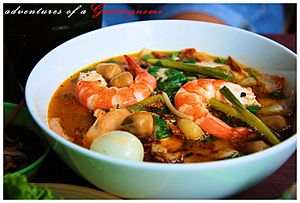Hủ tiếu facts for kids

A delicious bowl of Hủ tiếu.
|
|
| Course | Breakfast, lunch, and dinner |
|---|---|
| Place of origin | South Vietnam |
| Region or state | Southeast Asia |
| Associated national cuisine | Vietnamese and Thai |
| Created by | Vietnamese, Chinese, Cambodian cuisine |
| Main ingredients | Rice hủ tiếu, pork, chicken, seafood, broth |
| 400 kcal (1675 kJ) | |
| Similar dishes | Kuyteav, Kyay oh, Shahe fen |
| Hủ tiếu | |||||||||||
|---|---|---|---|---|---|---|---|---|---|---|---|
| Chinese name | |||||||||||
| Chinese | 粿條 | ||||||||||
|
|||||||||||
| Vietnamese name | |||||||||||
| Vietnamese alphabet | hủ tiếu | ||||||||||
| Thai name | |||||||||||
| Thai | ก๋วยเตี๋ยว | ||||||||||
Hủ tiếu is a super popular noodle dish from Vietnam. People often eat it for breakfast, but it's great for lunch or dinner too!
You can enjoy Hủ tiếu in two main ways. It can be a warm soup (called hủ tiếu nước) with lots of broth. Or, you can have it dry (called hủ tiếu khô) with no broth, and sometimes a small bowl of broth on the side.
This tasty dish became very popular in the 1960s. It was especially loved in Saigon, a big city in Southern Vietnam. The main parts of Hủ tiếu are a rich broth, different kinds of noodles, fresh herbs, and various meats.
You might have even seen Hủ tiếu on TV! Famous chef Gordon Ramsay featured it on MasterChef US in 2013. He said it was one of his favorite dishes. He also tried it on his show "Gordon's Great Escape" in 2010-2011, while visiting a floating market in Can Tho, Vietnam.
Contents
Where Did Hủ tiếu Come From?
Hủ tiếu has an interesting history. It was first brought to Vietnam by the Teochew people. These people moved to Vietnam from a part of China called Guangdong province.
The very first version of Hủ tiếu was called kuay teow. Its rice noodles were soft and flat, a bit like the noodles in phở. But over time, people in Southern Vietnam changed the noodles. They made them chewier, which is how most Hủ tiếu noodles are today.
The name "Hủ tiếu" itself comes from the Teochew language. It's their word for "rice noodles."
What's in a Bowl of Hủ tiếu?
A typical bowl of Hủ tiếu has three main parts. These are the flavorful broth, the noodles, and various yummy toppings.
The Noodles for Hủ tiếu
There are a few different types of noodles you can find in Hủ tiếu. Some bowls use soft rice noodles. Others might have egg noodles. There are also chewy tapioca noodles.
The tapioca noodles are special because they are very chewy and look a bit see-through. These are often used in a type of Hủ tiếu called Hủ tiếu Mỹ Tho. They are known as Hủ tiếu dai, which means "chewy Hủ tiếu."
The Delicious Broth
The broth is super important for Hủ tiếu. It's usually made by simmering pork bones for a long time. Sometimes, dried squid and dried shrimp are added to give it even more flavor.
In Southern Vietnam, the broth is often made a little sweet. This matches the local taste preferences. Remember, you can have your Hủ tiếu with lots of broth (wet) or with just a little (dry). If it's dry, you usually get a separate bowl of hot broth on the side.
Toppings and Garnishes
Hủ tiếu comes with many different toppings. You might find sautéed ground pork or thin slices of pork liver. Some bowls have pork intestines or poached shrimp.
Fresh greens like Chinese celery and chives are often added. You'll also see crispy sautéed garlic and shallots. You don't have to have all these toppings. You can pick and choose what you like best! This is why there are so many different kinds of Hủ tiếu dishes, like Hủ tiếu Mỹ Tho, which often includes seafood.
Different Kinds of Hủ tiếu
There are many popular ways to enjoy Hủ tiếu. Each one has its own special twist:
- Hủ tiếu Nam Vang (meaning "Hủ tiếu Phnom Penh") – This version comes from a Cambodian dish called kuyteav.
- Hủ tiếu sa tế ("Shacha Hủ tiếu") – This one is based on a dish from the Teochew people and has a unique spicy flavor.
- Hủ tiếu Mỹ Tho – This type is often served with prawns, octopus, cuttlefish, and snails. It uses thin, white rice noodles.
- Hủ tiếu Sa Đéc – This version is known for its special white rice noodles.
Hủ tiếu gõ is a fun street food version of Hủ tiếu. The name "gõ" means "knocking." This is because the people selling it often push their carts around and make a knocking sound. They hit two metal bars together to let everyone know they are selling Hủ tiếu!
Images for kids




